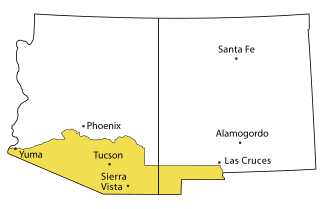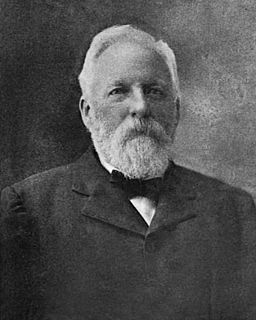
August Valentine Kautz was a German-American soldier and Union Army cavalry officer during the American Civil War. He was the author of several army manuals on duties and customs eventually adopted by the U.S. military.
John Irvin Gregg was a career U.S. Army officer. He fought in the Mexican–American War and during the American Civil War as a colonel and near the end of the war as a brevet general in the Union army. In 1866, he was nominated and confirmed as a brevet major general of volunteers and a brevet brigadier general in the Regular Army, both to rank from March 13, 1865.

The 4th California Infantry was a volunteer infantry regiment recruited from northern California during the American Civil War. It was organized at Sacramento, Placerville, and Auburn in September and October 1861.
The Weekly Arizonian was a newspaper published in Arizona Territory with a checkered existence from 1859 to 1871. It holds a special place in Arizona history as its first printed work, first newspaper and first political organ.
The 1st Dakota Cavalry was a Union battalion of two companies raised in the Dakota Territory during the American Civil War. They were deployed along the frontier, primarily to protect the settlers during the Sioux Uprising of 1862.

Prior to the adoption of its name for a U.S. state, Arizona was traditionally defined as the region south of the Gila River to the present-day Mexican border, and between the Colorado River and the Rio Grande. It encompasses present-day Southern Arizona and the New Mexico Bootheel plus adjacent parts of Southwestern New Mexico. This area was transferred from Mexico to the United States in the Gadsden Purchase of 1853. Mining and ranching were the primary occupations of traditional Arizona's inhabitants, though growing citrus fruits had long been occurring in Tucson.

The 2nd Regiment California Volunteer Infantry was an infantry regiment in the Union Army during the American Civil War. It spent its entire term of service in the western United States. Organized at San Francisco and Carson City September 2, 1861, to December 30, 1862, and attached to Department of the Pacific. The regiment was first assembled at the Presidio, San Francisco, and after completing its organization, five companies were sent to Oregon and Washington Territory, to relieve the regular troops, and two companies were sent to Santa Barbara. The troops of this regiment sent to Oregon were afterwards returned to California. It was mustered out during the month of October, 1864.
The 1st Battalion of Native Cavalry, California Volunteers was a cavalry battalion in the Union Army during the American Civil War. Recruits were largely drawn from the Californio population, though its ranks included Yaqui and Mission Indians as well as immigrants from Mexico, Hispano America and Europe. In addition to its ethnic makeup, the Battalion is also considered unusual for being one of the few lancer units in the United States Army.

The 5th Regiment California Volunteer Infantry was an infantry regiment in the Union Army during the American Civil War. It spent its entire term of service in the western United States, attached to the Department of the Pacific and Department of New Mexico.
The 7th California Infantry Regiment was an infantry regiment in the Union Army during the American Civil War. It spent its entire term of service in the western United States, attached to the Department of the Pacific, serving in California and Arizona Territory. They were known as the "Gold Diggers" in reference to the large number of recruits from the California's "Mother Lode" region. Later, they were also called the "Hungry Seventh" for the privations they suffered in Arizona, particularly at Fort Mason. The Regiment included many veterans of the Mexican–American War.
The 6th Regiment California Volunteer Infantry was an infantry regiment in the Union Army during the American Civil War. It spent its entire term of service in the western United States attached to the Department of the Pacific. The Regiment was organized at Benicia Barracks, San Francisco on February 1, 1863. 6th Regiment mustered out from October 25 to December 20, 1865. The only recorded engagements of the Regiment occurred with the detachment sent to the Humboldt Military District in 1864, near the end of the Bald Hills War. It had engagements with the Indians in the Skirmish at Booth's Run, May 1 and Kneeland's Prairie May 2, near Boynton's Prairie May 6 and at Grouse Creek May 23.

The 1st Battalion of California Veteran Infantry was a California Volunteer infantry battalion in the Union Army during the American Civil War. It spent its entire term of service in the western United States.

Clarence Edmund Bennett (1833–1902), usually referred to as Clarence E. Bennett, a graduate of West Point, a career American Army officer who saw duty almost exclusively in Western frontier assignments, served in the American Civil War in California, New Mexico and Arizona Territories and later in Reconstruction occupation forces and frontier duty during the later Indian Wars.

James Henry Carleton was an officer in the U.S. Army and a Union general during the American Civil War. Carleton is best known as an Indian fighter in the southwestern United States.
Edwin Augustus Rigg (1822–1882), 49er, was a military officer in the American Civil War and the Apache Wars.
Joseph Nelson Garland Whistler was a career United States Army officer. He served in the Mexican–American War and received a brevet appointment for distinguished service in the Battle of Contreras and the Battle of Churubusco. At the beginning of the American Civil War, Whistler was among the U.S. Regular Army officers taken prisoner by Confederates in Texas in April 1861 and paroled but was not exchanged until August 15, 1862. In 1863, he became colonel of the 2nd New York Heavy Artillery Regiment. He received a promotion and four brevet appointments in the regular army for his service during the Overland Campaign, specifically the Battle of North Anna, and the Siege of Petersburg, specifically the Second Battle of Petersburg. He was nominated on January 13, 1866 and confirmed on March 12, 1866 for appointment to the grade of brevet brigadier general of volunteers, to rank from March 13, 1866. He retired in on October 19, 1886 as colonel of the 15th U.S. Infantry Regiment.

Sidney Randolph DeLong was the first elected mayor of Tucson, Arizona. Elected in 1871 for a one-year term, the municipality formed the township of Tucson with two sections of land purchased from the U.S. government. In 1874 DeLong represented the Tucson area in the 8th Arizona Territorial Legislature.
Lorenzo Sitgreaves was a U.S. Army officer from Pennsylvania who led the 1851 Sitgreaves Expedition down the Zuñi and Colorado rivers.
1st Arizona Volunteer Infantry was an infantry regiment in federal service from Arizona Territory that served under special provisions during the Apache wars in 1865–1866. The regiment was primarily raised among the native and indigenous population of Arizona, Mexicans, Maricopas, and Pima. It was thwarted by the US Army, and disbanded when the federal government refused to continue funding.

Calabasas is a former populated place or ghost town, within the Census-designated place of Rio Rico, a suburb of Nogales in Santa Cruz County, Arizona.






